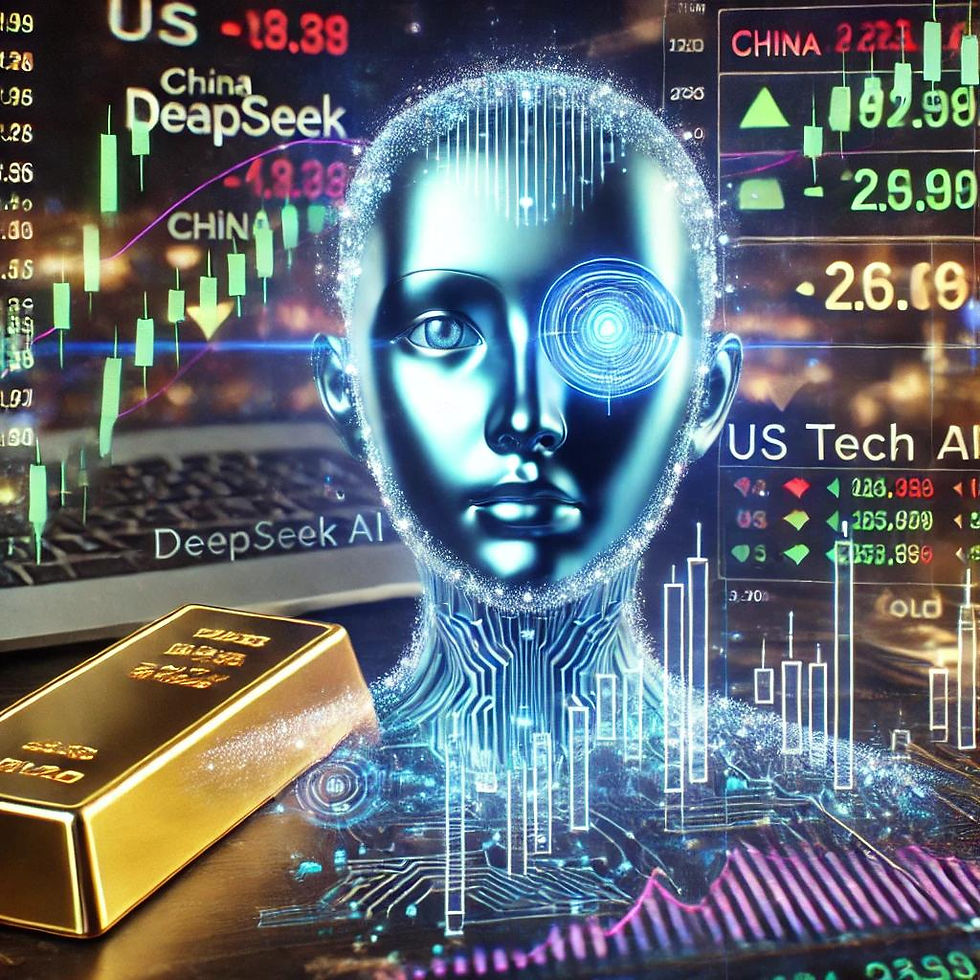China’s DeepSeek AI: A Game-Changer for Financial Markets and Global Stability?
- johnwick

- Feb 6
- 3 min read

In a stunning development, China’s DeepSeek artificial intelligence (AI) platform has taken the tech world by storm, outperforming its American counterparts, including OpenAI, while using just a fraction of the resources. This has led some analysts to label it an “OpenAI killer.” But what does this mean for financial markets, global stability, and the future of economic dominance?
The Rise of DeepSeek and What It Means for AI
Technology has always progressed at an accelerating pace, becoming more efficient, more affordable, and more powerful over time. This trend has been evident since the Industrial Revolution and has now reached an inflection point with AI.
DeepSeek’s emergence wasn’t unexpected in hindsight—it’s part of the natural progression of innovation. However, what has surprised many is its ability to leap ahead of US-based AI models despite China’s historically restrictive tech environment. This suggests that the balance of power in the AI sector may be shifting eastward at a much faster rate than anticipated.
US Response: A Necessary Investment or a Boondoggle?
In response to AI advancements from China, President Trump recently announced a $500 billion investment in AI development to secure US technological dominance. However, with DeepSeek already outpacing US models, some question whether this massive expenditure is a necessary push or an inefficient use of capital.
Historically, breakthrough innovations have not been driven by government initiatives but rather by individuals and small, agile teams. From Thomas Edison to the Wright Brothers to Steve Jobs, innovation has been the domain of visionary entrepreneurs, not bureaucrats. Government involvement, particularly in emerging technologies, often leads to inefficiencies, misallocation of resources, and, potentially, a militarization of AI that could be more harmful than beneficial.
As AI continues to evolve, concerns are mounting about its potential misuse. Governments worldwide, including the US, are likely to channel AI development into military applications rather than civilian advancements, raising ethical and security questions about the future of AI in geopolitics.
China’s Rapid Technological and Economic Ascent
DeepSeek’s success underscores China’s rapid technological ascent over the past four decades. Once an agrarian economy, China has transformed into a technological powerhouse, boasting a workforce highly skilled in science, technology, engineering, and mathematics (STEM).
Unlike the US, where many students opt for liberal arts and social sciences, China has a workforce heavily concentrated in STEM fields. In 2020 alone, China produced 3.57 million STEM graduates compared to the US’s 820,000. This vast talent pool gives China a significant advantage in AI development and other high-tech industries.
While critics argue that China’s AI success is built on intellectual property theft, historical precedents suggest otherwise. The US was once accused of stealing British technology during its early years of industrialization. Innovation, at its core, builds upon previous advancements—standing on the shoulders of giants rather than simply replicating their work.
Implications for Financial Markets and Investors
The impact of DeepSeek has already rippled through global financial markets. US tech stocks, including industry giants like NVIDIA, have seen sharp declines, losing billions in market capitalization overnight. The extreme concentration of market value in just a handful of US tech companies has made the sector highly vulnerable to disruptions like DeepSeek.
Historically, the phrase “high-tech, big wreck” has proven true in market cycles. AI is a high-risk, high-reward sector, and while it presents opportunities for early-stage investors, the current AI giants may struggle to maintain their dominance.
For investors, the key takeaway is not to gamble on overvalued tech stocks but to use AI as a tool to enhance personal and business productivity. Rather than betting on corporations whose black-box algorithms are impossible to scrutinize, individuals can leverage AI to optimize their financial strategies, including diversifying into assets like gold.
Gold as the Ultimate Hedge Against Technological Uncertainty
While AI and tech stocks experience volatile cycles, gold remains the only financial asset that is not simultaneously someone else’s liability. As history has shown, economic uncertainty and technological disruptions often lead to surges in gold prices.
With AI advancements introducing new risks to global stability—whether through economic shifts, government intervention, or even cyber warfare—gold provides a hedge against these unknowns. As AI reshapes the global economic landscape, owning tangible, time-tested assets becomes more crucial than ever.
Final Thoughts
The rise of China’s DeepSeek AI is a watershed moment, signaling a shift in technological power dynamics. Whether the US government’s massive AI investment will be a productive initiative or a bureaucratic misstep remains to be seen. However, one thing is clear: financial markets are entering an era of heightened volatility, and traditional safe havens like gold are more relevant than ever.
Investors should focus not just on AI as an investment but as a tool to improve their decision-making processes. In a world of rapid change, the best defense is a well-diversified portfolio, and gold remains a cornerstone of stability amid technological disruption.



Comments